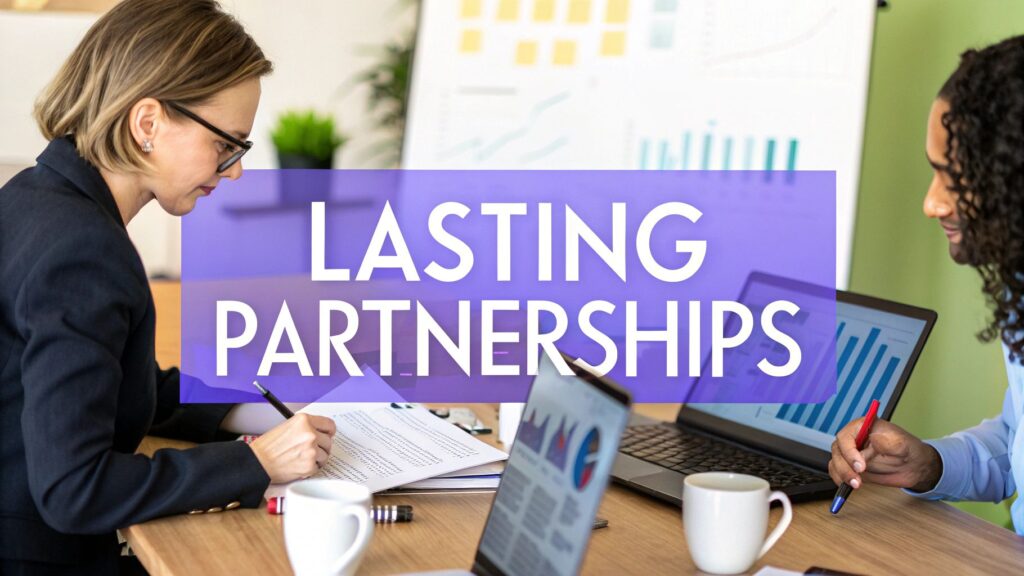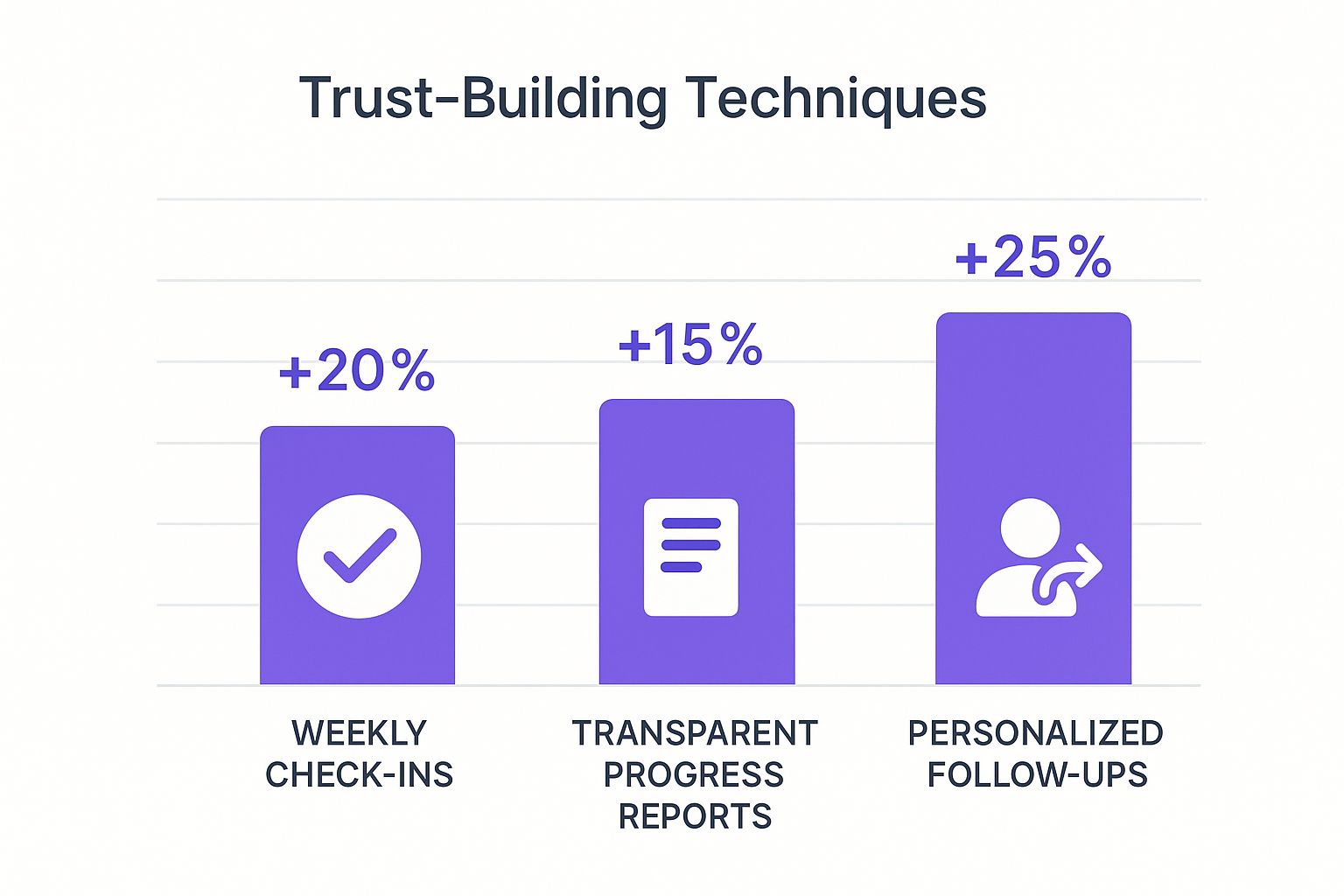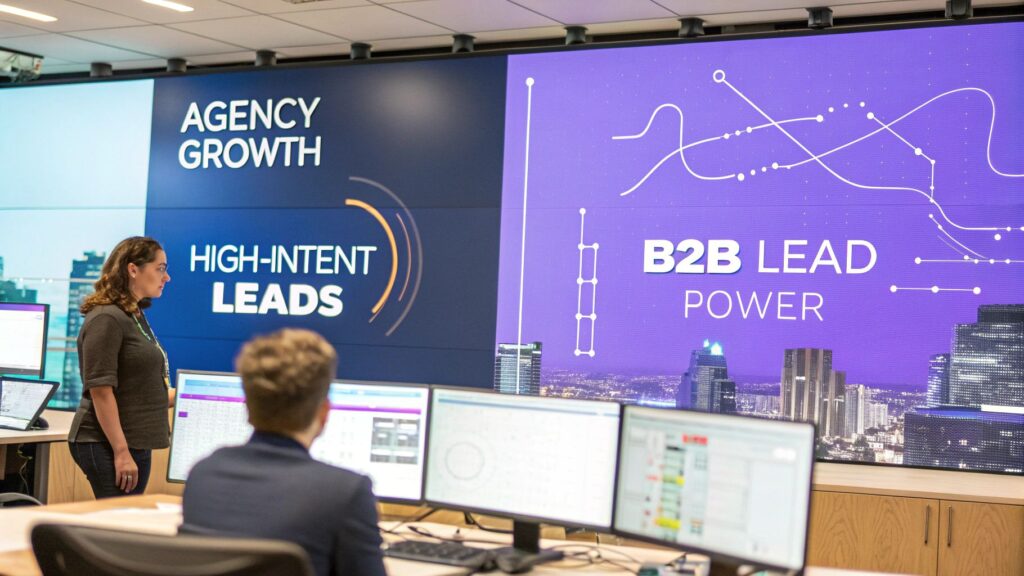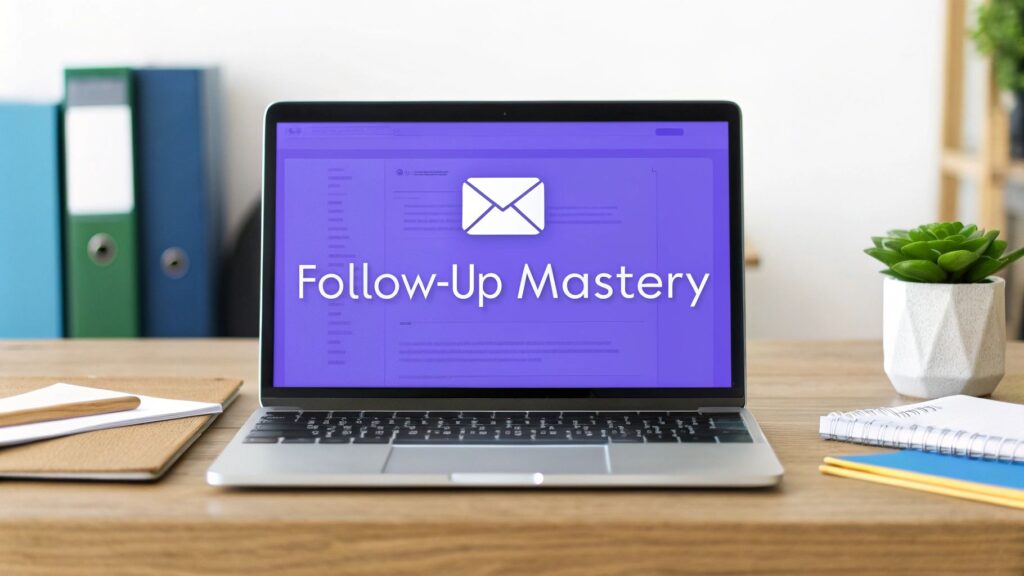How to Build Client Relationships That Last

- Why Strong Client Partnerships Are Your Greatest Asset
- Mastering Proactive and Honest Communication
- Using Technology to Personalize Every Interaction
- Building Unbreakable Trust Through Consistent Value
- Creating Actionable Client Feedback Loops
- Turning Loyal Clients Into Vocal Advocates
- Got Questions? We've Got Answers
Building a great client relationship isn’t about some grand, one-off gesture. It’s about the small, consistent, and thoughtful things you do every single day. The real blueprint for success comes down to four key pillars: proactive communication, deep personalization, unwavering trust, and delivering consistent value. When you get this blend of genuine human connection and smart processes right, you’re not just keeping a client happy—you're building a foundation for long-term growth.
Why Strong Client Partnerships Are Your Greatest Asset
In any agency or service business, your client relationships are more than just a "nice-to-have." They are the absolute engine for sustainable success. Think about it: strong partnerships directly slash churn, saving you the incredibly high cost of constantly chasing new customers. According to research by Frederick Reichheld of Bain & Company, acquiring a new customer is anywhere from 5 to 25 times more expensive than retaining an existing one.
When clients truly trust you, they become your best salespeople. They turn into vocal advocates, referring new business and leaving powerful testimonials that you simply can't buy. This foundation of trust is what shifts the dynamic from a transactional vendor relationship to a true collaborative partnership. Suddenly, you're not just a line item on their budget; you're an essential part of their team.
To really get this right, you need to understand what is client relationship management at its core. It’s a deliberate strategy, not just a series of friendly check-ins.
The Modern Approach to Relationship Building
Today, building client relationships has evolved into a strategic discipline, often supercharged by technology that helps us personalize at scale. The global CRM software market was valued at a staggering USD 101.41 billion in 2024 and is expected to hit USD 262.74 billion by 2032. That’s a clear signal of just how much companies are investing in getting this right.
This isn’t just about fancy software. It's about using tools to manage client information intelligently, which translates into faster problem-solving and more proactive support. You can dive deeper into the growth of CRM technology on fortunebusinessinsights.com.
The ability to turn a one-time project into a long-term partnership is the ultimate competitive advantage. It's not about being the cheapest or the fastest; it's about being the most trusted.
Ultimately, a structured approach to your relationships underpins every successful growth strategy. For any agency owner looking to scale, these principles are a perfect match for proven business development best practices. By blending genuine connection with strategic execution, you create partnerships that don't just survive—they thrive.
Mastering Proactive and Honest Communication

Great communication is the bedrock of any solid client relationship. It's so much more than just the occasional "checking in" email. We're talking about a deliberate, strategic rhythm that keeps everyone on the same page and nips misunderstandings in the bud. Real partnership blossoms when clients know exactly what to expect from you, and when.
This all starts on day one. That very first kickoff call is your chance to hash out and agree on the communication framework. It’s not just about scheduling a weekly meeting; it’s about agreeing on the ground rules for how you'll talk to each other. When everyone’s aligned on the process from the get-go, you lay a foundation of reliability that will carry you through the entire engagement.
Setting Clear Expectations from Day One
Think of the onboarding phase as your golden opportunity to create a "communication charter." This doesn't have to be a stuffy, formal document. It can be a shared understanding that simply outlines the key interaction points, leaving no room for guesswork. It's a surprisingly simple tool that works wonders for building trust.
Your charter should spell out a few key things:
- Response Times: What's a reasonable turnaround for emails and calls? Agreeing on something like a 24-hour response window for non-urgent matters keeps clients from feeling ignored and helps your team manage their time without feeling constant pressure.
- Meeting Agendas: Make a pact to send a clear agenda at least a day before any scheduled meeting. This little bit of prep work shows you respect everyone's time and keeps the conversation focused on meaningful outcomes, not just wandering updates.
- Key Contacts: Who do they call for what? Clearly define the go-to person for billing, project management, or technical questions. It streamlines problem-solving and makes your agency look incredibly organized.
This kind of proactive planning takes the guesswork out of the relationship and shows you’re a professional partner, not just a vendor.
Turning Difficult Conversations into Trust-Building Moments
Let's be real—sometimes things go wrong. A deadline gets missed, a campaign underperforms, or the budget needs to be revisited. How you handle these moments is what separates the great agencies from the rest. A tough conversation can either crack the foundation of your relationship or, believe it or not, make it even stronger. It all comes down to how you communicate.
Honesty isn't just the best policy; it's the only policy. Time and again, clients have shown they value transparency far more than they expect perfection. The second you realize something is off track is the second you need to pick up the phone. Letting a client discover a problem on their own is the fastest way to destroy trust. For a deeper dive, it's worth brushing up on client communication best practices.
Whenever you have to deliver bad news, walk into the conversation with three things: a straightforward explanation of what happened, an honest take on the impact, and a proactive plan with a few potential solutions. This approach instantly shifts you from a vendor reporting a problem to a partner actively solving it.
For instance, instead of a vague, "We're running a bit behind schedule," try something more concrete: "The new feature launch is delayed by three days because of an unexpected API conflict we discovered. We've already pulled in two more developers to tackle it and are confident we'll be back on track by Friday. I've attached a revised timeline for your review."
See the difference? It shows ownership, provides a solution, and builds confidence, even when the news isn't great.
Using Technology to Personalize Every Interaction
Let’s be clear: technology should never replace the human touch in your client relationships. Instead, think of it as the powerhouse that makes genuine, personal connections possible, even when you're managing dozens of accounts. When you get it right, the right tools make every client feel like they're the only one you're focused on.
This is where a good Customer Relationship Management (CRM) system becomes an agency's best friend. Forget seeing it as just a digital rolodex. Your CRM should be a living, breathing hub of client intelligence—the single place where every conversation, milestone, personal tidbit, and business goal is tracked. Powerful tools like Salesforce CRM solutions can completely change the game, turning what looks like simple data into real opportunities to build rapport.
Imagine your CRM pings you with a notification: one of your best clients just hit their 10-year business anniversary. Firing off a quick, personal "Congrats!" email takes seconds, but it shows you’re paying attention to their world beyond the scope of your current project. Small gestures like this prove you’re invested in their success, not just their budget.
From Data Points to Meaningful Connections
The real magic happens when technology helps you weave scattered pieces of information into a cohesive story about your client. By keeping track of the little details, you can graduate from generic "just checking in" emails to providing timely, tangible value that solidifies the partnership.
This approach lets you:
- Share Hyper-Relevant Content: Your client mentions an off-hand interest in sustainable business practices. You tag it in your CRM. A month later, you see a new industry report on that exact topic. Sending it their way with a note like, "Saw this and immediately thought of our conversation," is incredibly powerful.
- Acknowledge Key Milestones: Keep an eye on project anniversaries, product launch dates, or even personal details they’ve shared, like an upcoming marathon. A simple acknowledgment proves you're not just hearing them—you're listening.
- Anticipate Their Next Move: Analyzing past project data and communication patterns can help you spot trends. For example, if you notice their web traffic from a specific channel has dipped for two consecutive months, you can proactively suggest a new campaign to address it before they even bring it up.
The chart below really drives home how much these personalized touchpoints matter when it comes to earning a client's trust.

As the data shows, consistent communication is the baseline. But it's those thoughtful, personalized actions that truly move the needle on trust.
Choosing Your Relationship-Building Tech Stack
Selecting the right tools is crucial for turning your relationship-building strategy into a scalable process. A well-curated tech stack automates the administrative heavy lifting, freeing up your team to focus on what matters most: the clients themselves.
| Tool Category | Primary Function | How It Strengthens Client Relationships |
|---|---|---|
| CRM System | Centralizes all client data, interactions, and history. | Provides a 360-degree view of each client, enabling deep personalization and proactive communication. |
| Communication Platform | Integrates email, chat, and video calls in one place. | Keeps conversations organized and accessible, ensuring no detail or request falls through the cracks. |
| Project Management Tool | Tracks tasks, timelines, and deliverables. | Offers transparency into project progress, building trust and keeping everyone aligned on goals and deadlines. |
| Feedback & Survey Tool | Gathers client feedback at key project stages. | Creates a formal channel for clients to share their thoughts, making them feel heard and valued. |
| Analytics & Reporting | Measures campaign performance and ROI. | Demonstrates the tangible value you're delivering, reinforcing their decision to partner with you. |
Ultimately, these tools work together to create a seamless experience for both your team and your clients, ensuring that every interaction is informed, personal, and impactful.
The Rise of AI in Relationship Management
Artificial Intelligence (AI) is quickly becoming a non-negotiable part of the modern CRM. In fact, the CRM market is projected to grow by 9.8% annually, hitting an estimated USD 178.7 billion by 2034, with AI being a massive driver of that growth.
AI-powered features can automatically transcribe and analyze sales calls, pull key insights from email threads, and flag at-risk accounts before issues escalate. This drastically reduces manual data entry and human error, giving your team more time for strategic thinking and genuine conversation.
Technology’s role in client relationships is to handle the rote task of remembering so you can focus on the human act of caring. It’s there to automate the process, not the personality.
By letting AI handle routine follow-ups or generate performance insights, you can stay focused on the high-impact activities that truly nurture the partnership. It’s all about using technology to amplify—not replace—the real connection that keeps clients coming back.
Building Unbreakable Trust Through Consistent Value

Trust isn't something you can just check off a list in your project management software. It’s the invisible currency that powers every single successful client relationship. You earn it bit by bit, through every interaction, every met deadline, and every promise you keep.
This foundation isn't built on grand, one-off gestures. It's built on simple, reliable consistency.
When you consistently deliver quality work on schedule, you become a predictable, dependable partner. This is the first and most crucial layer of trust. Your clients learn they don't have to worry about your part of the puzzle, which frees up their mental bandwidth to focus on their own business.
But the real magic happens when you move beyond the contract. True, unbreakable trust is forged when you start delivering value they never even asked for. This is how you go from being a capable vendor to an indispensable partner.
Going Beyond the Scope of Work
One of the most powerful things you can do to build a rock-solid relationship is to deliver value that isn't explicitly listed in the scope of work. It’s a clear signal that you’re not just punching a clock; you’re genuinely invested in their success.
This kind of proactive value can take many forms. For instance:
- Sharing Strategic Insights: You come across an industry report that has major implications for your client's Q4 strategy. You shoot it over with a quick summary of the key takeaways just for them.
- Identifying New Opportunities: While digging into their campaign data, you uncover a new audience segment they haven't targeted. You put together a mini-proposal outlining the potential.
- Offering a Helping Hand: Your client casually mentions they’re struggling to find a good freelance designer for a small, unrelated project. You immediately connect them with a trusted contact in your network.
These actions show you care about their entire business, not just the slice you were hired to manage. You’re no longer just a service provider; you’re a strategic ally.
The moments that truly define a client relationship are rarely the easy wins. They are the moments of friction—a missed deadline, an unexpected result, a mistake—and how you choose to handle them.
Owning Your Mistakes with Grace
Look, no matter how talented your team is, things will go wrong. A campaign will underperform. A technical glitch will cause a delay. Mistakes happen. While the gut reaction might be to downplay the issue, how you respond is a massive opportunity to build trust. It's a sobering thought, but research shows only about 25% of customers truly trust companies.
Transparency here is absolutely non-negotiable. The second you realize something is off, you need to be the one to bring it to their attention.
Here's a simple, three-part framework for owning any mistake:
- Acknowledge It Clearly: Get straight to the point. "I'm calling to let you know we made an error on the latest ad spend allocation." No sugarcoating.
- Explain the Impact: Be honest about what happened. "This means we overspent the budget by 5% for this week."
- Present a Solution: Immediately follow up with your plan. "We've already reallocated funds from next week to balance it out, and I've put a new review process in place to make sure this doesn't happen again."
This approach screams accountability. By taking ownership and bringing a solution to the table—not just a problem—you can turn a negative into a positive. It proves you're a partner who can be counted on, especially when things don't go perfectly.
Creating Actionable Client Feedback Loops
If you want to truly understand your clients and build a lasting relationship, you have to stop thinking of feedback as a once-a-year event. An annual survey? That's ancient history. It's way too little, way too late.
Think of feedback as an ongoing conversation—a living, breathing part of your partnership. When you get it right, this continuous dialogue doesn't just help your client grow; it actively fuels your agency's improvement, too. This isn't about just asking, "Are you happy with our work?" Real feedback loops are structured and consistent. They’re designed to uncover the kind of insights that forge an unbreakable partnership. By creating a predictable rhythm for these conversations, you make clients feel genuinely heard and show them you’re all in on their success.
Moving Beyond the Basic "Are You Happy?" Question
Let's be honest: generic questions get generic answers. If you want valuable feedback, you have to ask better, more thoughtful questions that make your clients think.
A quarterly business review (QBR) is the perfect time and place for this. Don't just run through the numbers. Dedicate a specific part of every QBR to checking the pulse of the relationship itself.
Try asking questions that open up the conversation:
- "Looking ahead to the next quarter, what’s the single biggest challenge you see coming down the pike for your team?"
- "Beyond the project work, how could we be a better strategic partner for you?"
- "Is there anything in our communication or reporting process that feels clunky or could be more efficient?"
These kinds of questions shift the entire dynamic. You’re no longer just talking about satisfaction; you're focused on forward-thinking collaboration. You'll uncover opportunities to add value that your client might not have even considered. While a strong pipeline is crucial—you can learn more about building one with effective lead generation for agencies—it's this commitment to deepening relationships that creates real, long-term stability.
The most critical part of the feedback loop isn't asking for it—it's visibly acting on it. When a client sees their suggestion implemented, it proves their voice has a genuine impact on the partnership.
I’ve seen this play out time and again. Say a client mentions your weekly reports are a bit too dense. Don't just nod and file it away. The very next week, add a one-page executive summary to the top of the report.
Then, send a quick note: "Based on your feedback, we've added a quick summary to make these reports easier to digest." That small move does something huge. It closes the loop and proves you’re not just a vendor, but an attentive partner who is genuinely invested in their experience. This is how you turn satisfied clients into your biggest fans.
Turning Loyal Clients Into Vocal Advocates
The real endgame in client relationships isn't just keeping them around; it's about turning them into your biggest fans. You want to move satisfied clients from simply being loyal to becoming your most enthusiastic, vocal advocates. This is the long game, where all your hard work shifts the dynamic from one-off projects to lasting, mutually profitable partnerships.
This evolution from loyalty to advocacy is built on a genuine connection. It’s about celebrating their wins like they’re your own. When a client you've worked with lands a huge deal or gets some great press, a quick congratulatory note shows you’re invested beyond the next invoice. Little things matter, too. Acknowledging partnership anniversaries with a simple "Happy 2-year anniversary of working together!" goes a long way in reinforcing the value you place on the relationship.
Identifying and Nurturing Your Future Champions
Let's be realistic: not every happy client will become a vocal advocate. The trick is to spot those who are already showing signs of a true partnership. These are the clients who give thoughtful feedback, genuinely appreciate your work, and already treat you like a strategic advisor, not just a vendor.
There's a reason the Customer Relationship Management (CRM) market is so massive—it was valued at USD 73.40 billion in 2024 and is expected to reach USD 163.16 billion by 2030. Tools like these are essential for tracking the small details that signal a client is primed for advocacy. You can dig into more data on the explosive growth of the CRM market at Grand View Research.
Once you've identified a potential champion, asking for that testimonial or referral has to feel completely natural, never forced.
The best time to ask for a referral is right after you've delivered a major win or they've just sent some glowing, unprompted feedback. Your value is fresh in their mind, making the request a logical next step, not a chore.
For example, right after a killer project launch, you could say, "We're so proud of what we achieved here. If you happen to know anyone else who could use this kind of success, we'd love an introduction." It's a soft ask that respects the relationship and frames advocacy as a natural extension of their own great results.
Of course, spotting these champions is much easier when you know exactly who you're looking for. This starts with a rock-solid understanding of what is an ideal customer profile. When you know who you serve best, you can spot and cultivate those perfect-fit advocates from a mile away.
Got Questions? We've Got Answers
Here are some of the most common questions we get about building client relationships that actually last.
What’s the single biggest thing that makes or breaks a client relationship?
If I had to boil it all down to one thing, it's trust. Hands down.
Everything else—great results, slick communication, creative genius—sits on a foundation of trust. You build it by being reliable time and time again, by communicating proactively (especially when the news isn't great), and by always, always acting in their best interest. A client who trusts you will stick with you through a minor hiccup, give you honest feedback, and see you as a true partner, not just another vendor.
So, how often should I actually be talking to my clients?
There’s no one-size-fits-all answer here, but the secret ingredient is consistency. Set a clear communication rhythm right from the kickoff call and stick to it. Whether it's a quick weekly email or a formal bi-weekly call, the client should know exactly when they'll hear from you.
The goal is to stay aligned and provide value, not to flood their inbox. Remember, a study by Bain & Company showed that just a 5% bump in customer retention can increase profitability by 25% to 95%. Consistent, predictable communication is a huge part of making that happen.
The best communication cadence is the one you agree on together at the start. It takes all the guesswork out of the equation and makes sure everyone is on the same page from day one.
What do I do when a client is genuinely unhappy?
First, take a deep breath and just listen. Don't jump in with excuses or defenses. Let them get it all out, and then acknowledge their frustration to show you're actually hearing them.
Next, if your team dropped the ball, own it. Full stop. A simple, "You're right, we made a mistake," is incredibly powerful. Finally, pivot the conversation from what went wrong to how you're going to make it right. Present a clear, actionable plan to fix the immediate problem and outline the steps you'll take to ensure it never happens again.
At FundedIQ, we know that great client relationships start with finding the right clients. Our platform gives you curated lists of recently funded startups—the high-intent prospects you need to build strong, lasting partnerships from the very beginning. Start finding your ideal clients today.





